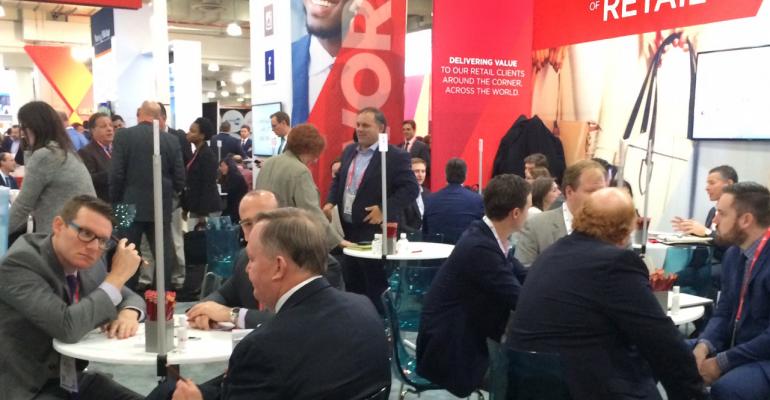Attendees at this year’s ICSC New York’s National Deal-Making Conference tell us the mood on the floor is generally optimistic, and the buzz of businesses filling the halls of level one at Jacob Javits Center seemed to echo that.
“There’s definitely energy at the show. The election is over, people are cautiously optimistic about retail,” says Hal Shapiro, senior director at Winick Realty Group.
Here we present nine takeaways from interviews with industry professionals on the show floor.
- Deals are taking longer to close, as the decision-making for site selection is becoming a longer process, says Anjee Solanki, national director of U.S. retail services with Colliers International. Retailers are becoming more active in site selection and more selective in the types of store formats they want in specific markets. “Retailers are now asking to see the numbers,” Solanki says, adding “data is a must” in their strategy decisions.
- Rents undergo a market correction: The softening of rents across some retail property types shows “the market is correcting,” Solanki says. “Deals are still being done, especially if you have good co-tenancy and location, but you are no longer going to garner rents like seen at the peak.” For tenants with good financial standing, landlords are now willing to offer not only several months of free rent, but also help with build-out costs, Shapiro says.
- Right-sizing, re-tenanting: The right tenant base is ever more important to landlords, who are putting more emphasis on store line-ups to create a sense of place, says Mike Longmore, executive vice president of retail at JLL. “Where institutional investors own retail, they are looking to re-tenanting,” Longmore says, adding that institutional investors don’t want the old model of regional malls. What’s needed today to get shoppers spending time at a retail center is a sense of experience that can’t be found online, according to Michael O’Neill, executive director, retail services, Cushman & Wakefield. “From a macro perspective, the incorporation of food and beverage into the mall and even street environment is really critical. You are seeing larger big-box opportunities repurposed for food holes—they offer a different level of [visit] frequency and an experience,” O’Neill notes.
- Fulfillment logistics are top of mind for retailers: E-commerce order fulfillment, particularly at the last mile, and then the reverse—logistics for returns—are a significant part of the omnichannel issues that retailers are dealing with right now, says Brandon Famous, senior managing director and retail occupier leader for Americas with CBRE.
- Following the investors: Institutional investors have grown more comfortable with mixed-use retail this year, according to Longmore, a trend that should continue in 2017 as investors chase higher returns. He adds that investors are weighing their acquisitions decisions increasingly based on net operating income (NOI) as they chase better cash flow. Institutional investors are increasing activity on deals in the $20 million to $30 million price bracket, according to Karen Hurd, senior vice president with SVN. Secondary markets are also becoming more in demand.
- Much ado about luxury retail? Luxury retailers had faced some challenges over the past 12 to 18 months, according to Cushman & Wakefield’s O’Neill, but “we are starting to see some limited expansion among the major luxury brands.” Meanwhile, luxury retail corridors are showing signs of being overpriced, according to Longmore, driven by “ego money.” Flagship stores in these locations are being used as more of a marketing tool than sales outposts, much like a billboard, he adds. At the same time, Longmore adds that certain corridors are expanding, including Fifth Avenue in New York, Michigan Avenue in Chicago and Lincoln Road in Miami.
- Greater focus on urban locations: Retailers are pursuing urban infill space opportunities because “they are chasing the critical mass,” says Melina Cordero, head of retail research-Americas for commercial real estate brokerage firm CBRE. “Where neighborhoods are expanding, urban retail is growing,” Famous notes. Urban retail corridors in 18-hour cities are very desirable to institutional investors, Longmore notes.
- Eyes on grocery-anchored: “We are seeing stabilizing cap rates for grocery-anchored retail, and we have not seen weakness in our rents,” says Jeff Edison, CEO of Phillips Edison, an owner and manager of grocery-anchored shopping centers. His firm closed about $800 million in transactions in 2016 and expects roughly the same for the year ahead. In 2017, Phillips Edison will be “property-focused on the operating side” after trimming its portfolio to dispose of less recession-proof assets and recycling capital from those sales into its public and private portfolios. Edison also notes that the firm is now signing leases at longer terms than average, for at least six years as opposed to three and a half or four years.
- International chains continue to move in: The movement of overseas chain into U.S. markets is growing as retailers seek to build global brands, Longmore says. Asian retailers are signing more leases in the U.S. than ever, contends CBRE Senior Director-Asia Joel Stephen. CBRE is working to bring new Asia-based retailers in the categories of eyewear, cosmetics and home furnishings to the U.S. this year. Potential trade and tariff regulations from the new Presidential administration may pose an issue in the future, but the active discussions he is holding with retailers currently haven’t changed, Stephen says. Latin America retailers are also looking to expand into the U.S. and Canada this year, says Cordero. “From one point of view, the clarity around [who the next administration will be] is a positive. With that said, there’s a concern and a wait-and-see approach from retailers. There are concerns about tariffs being imposed. But we are still kind of early in the process. Locally, it’s definitely created some concerns surrounding upper Fifth Avenue. Security there has increased significantly. There’s one school of thought that it will add another major tourist attraction to Fifth Avenue, but it will also significantly impact pedestrian traffic,” says O’Neill.
0 comments
Hide comments

